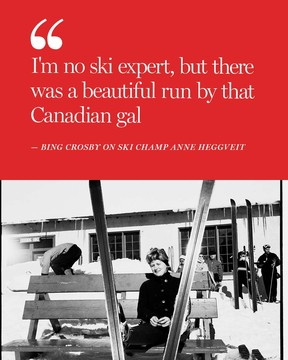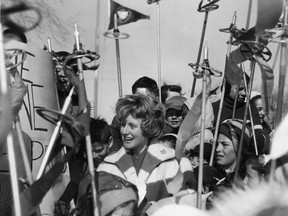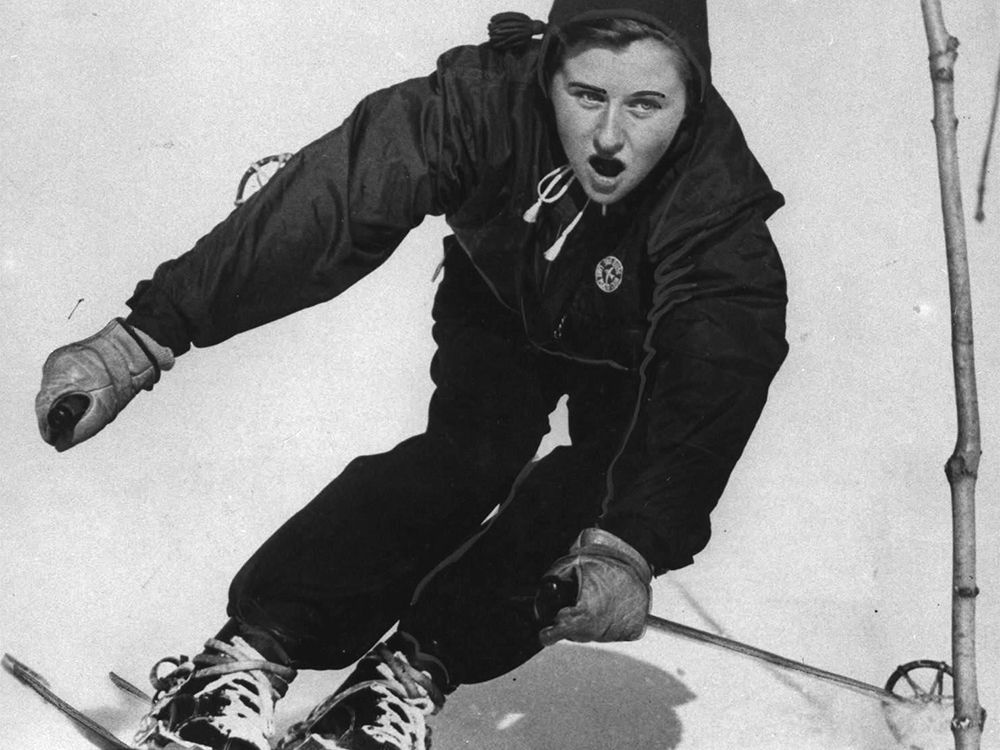Walter Cronkite interviewed her; Ed Sullivan introduced her to America, live and in person, on his show
Content item
Anne Hamilton has a dog to walk, specially-made shoes that let her move around pain-free, and a rowing machine in the garage.
Advertisement
This advertisement has not loaded yet, but your article continues below.
Content item
“I’m trying to stay fit,” she says with a laugh, “while paying for sins of the past.”
Those sins were committed on a pair of skis, and involved the things she put her body through on various mountain slopes as a young go-getter. In the last 10 years, the 83-year-old woman has had a knee replaced, and ankle-fusion surgery stemming from a decades-old spiral fracture in her leg.
She lives in North Carolina now, far from the Ottawa home of her youth. Some acquaintances know about her 1960 Olympic slalom gold medal, and her status as the first Canadian to win an Olympic event on skis.

Some have no idea.
“It’s not something I really talk about,” Hamilton says. “It’s just another lifetime.”
She was Anne Heggtveit then, and a real natural. Her father, Halvor Heggtveit, was a Canadian cross-country ski champion. Anne’s prowess on the boards got her a mention in the ottawa citizen at age two. At six, the “Ottawa mite” was filmed on the slopes by a Canadian army film unit and landed a full feature in the same paper, along with a photo.
Advertisement
This advertisement has not loaded yet, but your article continues below.
Content item
And so it went, accomplishments growing, until she’s 21 years old, 115 pounds, perched on two slim boards, winning an Olympic gold medal at Squaw Valley — “digging, swishing and swinging as she went,” wrote the Canadian Press.
“I’m no ski expert.” entertainer Bing Crosby said while watching from up close, “but there was a beautiful run by that Canadian gal, just wonderful.”
Walter Cronkite interviewed her; Ed Sullivan introduced her to America, live and in person, on his show.
She also won the Olympic combined, but the International Olympic Committee did not then give out gold medals for that. If they did, she’d have two.
“This is the greatest thing to happen to Canada in any Olympics,” team manager Andy Tommy unabashedly told reporters after that breakthrough performance.
Advertisement
This advertisement has not loaded yet, but your article continues below.
Content item
-

Scott Stinson: Beijing Olympics are kicking off the Year of Sportswashing
-

Just getting athletes to Beijing Olympics is a logistical nightmare
And then she retired, because there was nothing left to do in the sport, and national-team skiing in 1960 was not like national-team skiing in 2022.

(Photo: Bill Lingard Newton collection, Ottawa City Archives)
“I remember being asked afterwards, how did it feel?” Hamilton says now. “That’s a very difficult question. I trained, in my case, from age two until I was 21. And all of a sudden, what you were raised to do, you achieved. It’s gone. And you’ve got this void you’ve got to deal with, and to figure out who you are. I don’t care if you’re Simone Biles or who you are, you’ve got to — at some point — deal with that.
Advertisement
This advertisement has not loaded yet, but your article continues below.
Content item
“We didn’t have the kind of team support they have now. A lot of the fund raising was done at a local level. My ski club, my ski zone. Everybody was scrounging for money; there was no Alpine Canada or anything like that. The minute the Olympics was over, that was the end of our ski team for that year. We were funded to go to the Olympics, and then we go home.”
So Heggtveit, who had also competed at the 1956 Olympics, stepped away from elite skiing at the age of 21, after which she won the Lou Marsh Award as Canada’s top athlete for 1960.
She met and married Ross Hamilton, and raised a family. Decades later, she got the itch to return to school, and got her bachelor of science in accounting at 54 years old. She worked in that field for several years, then got into botany and photography. She made and sold flower arrangements; shot weddings; sold cards with her photographic work on them.
Advertisement
This advertisement has not loaded yet, but your article continues below.
Content item
She filled the void; chased and found her passions. She has the gold medal safely stashed away, and laughs when asked if she ever just stands and looks at the thing.
“You know, you can’t keep those around the house, though I do have a nice picture of it on the wall, a really good reproduction,” she says. “If I really feel like looking at something, I can look at that.
“The only time I really think about my old life and career,” she added, “is when the Olympics roll around, and I get calls like yours.”

But her memory is keen, and she’s full of stories. The night before racing the slalom at Squaw Valley, skiers had a chance to study the hard, fast Papoose Peak courses up close. She declined, because she knew she would then race them in her mind all night long, costing her precious sleep.
Advertisement
This advertisement has not loaded yet, but your article continues below.
Content item
The next morning, she climbed the hill and studied the first course, memorized the gates quickly, then did the same for the second course when it was time to run that.
After an excellent first run, she went for broke on the second.
“I decided I was going to crash or stand up,” she told reporters later, and won gold because she did the second and not the first.
Hamilton is a big believer in the mental side of the game. Taped beside her bed back then was a clipping on the power of positive thinking, and even today, when she sits in front of the TV and views the Olympics, she watches with a gold-medalist’s eye.
“You look at the top 20 or 25 women, they’re almost technically the same,” she says. “Really, the edge is all mental. It’s whoever can handle that, the mental aspect of it, at the right time. That’s the whole secret to it.”
Advertisement
This advertisement has not loaded yet, but your article continues below.
Content item
Hamilton was a slalom specialist, and also skied the giant slalom and downhill. But Slalom was her focus, and she saw it as the path to an Olympic medal. And that’s how it played out.
“A few of the home-town press who can remain unnamed — I don’t even know if they’re alive at this point — neglected to go to watch the race, because I’d had two 12th-place (finishes) in my two previous events,” she says with a laugh, referring to her showing in the giant slalom and downhill. “They admitted it, and they admitted where they were. Those were the days.”
Hamilton says she’ll watch the 2022 Winter Olympics with great interest — she loves the Summer Games, too — and will “keep hoping for some maple leaves up there on the podium.”
She had her knee replaced 10 years ago and hasn’t skied since, so there’s no chance Canada’s first-ever Olympic slopes winner will try to replicate whatever exploits she sees on the Chinese mountainside.
“You get to the point where to ski the way I like to ski, I’m not in shape to do that, so I’d be stupid to do it,” she says, laughing. “You have to think logically. But it’s fun to talk about it.”
kemitchell@postmedia.com
Advertisement
This advertisement has not loaded yet, but your article continues below.

“Coffeeaholic. Lifelong alcohol fanatic. Typical travel expert. Prone to fits of apathy. Internet trailblazer.”

